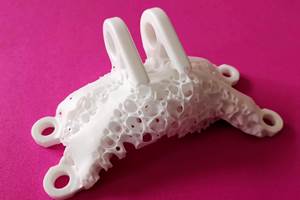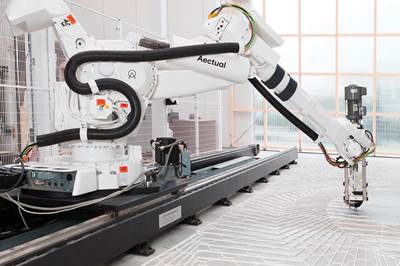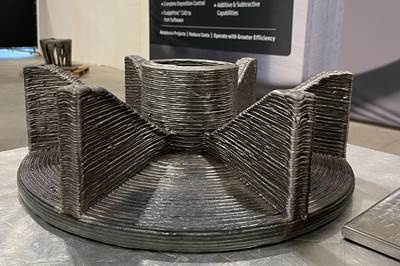ABB Introduces Software Capabilities to Simplify Robot Programming for AM (Includes Video)
Slicer software output can be converted to a robot program. The user chooses speed and precision of printing, but no specialized knowledge of robot 3D printing is needed.
Robots are ready to serve as fast and capable industrial 3D printers, but they are not necessarily easy to program for this application. Robot maker ABB has addressed this challenge with new 3D printing capabilities added to its simulation and programming software, RobotStudio, allowing the output of any third-party 3D printing slicer software to be converted automatically into a program for robot motion. No special knowledge of robot programming for 3D printing is required, the company says.
Robots are a natural fit for 3D printing. The programmable motion control of an industrial robot is easily precise enough for material-deposition 3D printing, while the long reach of a robot provides an option for large-format AM that is potentially more economical than a large, dedicated 3D printer necessitating a large enclosed machine frame.

In fact, other hardware to enable robotic 3D printing is ready to go as well. Extruders engineered for 3D printing provide an effective means of depositing material with a robot. Programming has presented the most significant remaining barrier to making use of these resources. In ABB’s case, programming a robot for 3D printing has, until now, generally required a third-party software tool combined with specialized robot programming skill.

3D printing capabilities added to the robot maker’s simulation and programming system now allow for easy generation of robot paths for additive manufacturing, starting with the file output from slicer software. Photo courtesy of ABB.
The company says the new RobotStudio capabilities allow a robotic additive manufacturing program for a new part to be created in about 30 minutes. The model first is input to slicer software. (A company representative noted Simplify3D and Ultimaker’s slicer software as tools ABB team members have applied effectively.) The slicer output is then input to RobotStudio. The user needs only to choose top-level characteristics such as the robot’s target-point density (for the precision of the additive build), the speed of traverse for deposition, and the wait time between layers. Robot path programming is then written automatically.
ABB is a leading industrial robot provider; the company’s robotics division has shipped about 400,000 robot solutions, the company says, across applications including part handling and welding — and AM. Lincoln Electric Additive Solutions, a provider of additive manufacturing capability in metal, uses ABB robots in its wire-arc AM platform.
At the recent Fabtech trade show, ABB demonstrated polymer 3D printing programmed with its new software using a robot equipped with a pellet-fed extruder from Massive Dimension. Here is video filmed at that event:
Related Content
Solving 3D Printing’s Hidden Problem: Vibration
Ulendo’s vibration compensation software can double the speed of FFF 3D printers while maintaining part quality, all without changing the machine’s hardware.
Read MoreSpherene Creates Metamaterial with Geometry Derived from Spheres
An algorithm developed by Spherene Inc. generates Adaptive Density Minimal Surfaces (ADMS) as a self-supporting infill strategy that can be used to reduce mass and manage material properties in 3D printed parts.
Read MoreDecentralized Manufacturing Network Aims to Make 3D Printers a Shared Global Resource
The 3DOS additive manufacturing network will let OEMs and creators take advantage of open 3D printer capacity anywhere in the world.
Read MoreAdditive Manufacturing Production at Scale Reveals the Technology's Next Challenges: AM Radio #28
Seemingly small issues in 3D printing are becoming larger problems that need solutions as manufacturers advance into ongoing production and higher quantities with AM. Stephanie Hendrixson and Peter Zelinski discuss 6 of these challenges on AM Radio.
Read MoreRead Next
Why Robots and Additive Manufacturing Go Together
3D printing and robots enable one another. We miss the possibilities of one if we do not consider the other. The combination includes AM for end effectors, robots for 3D printing parts, and different modes of metal and plastic production.
Read MoreFor Sustainable 3D Printed Architecture Think Renewable, Not Permanent
The design choices of today won’t be the trends of tomorrow. Aectual chooses to embrace changing tastes by making it easy to procure and recycle 3D printed architectural elements.
Read MoreThe Way Ahead for Wire Arc Additive Manufacturing
Tooling today, production tomorrow. The capability will advance as value is increasingly seen in lead time savings and design opportunities. Parts that today are cast offer a particularly promising application for a process that is “welding, except not.”
Read More





















